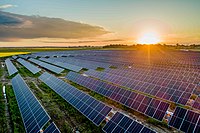
Photo from wikipedia
Abstract The optimal yawing angle of sun-tracking solar aircraft is tightly related to the solar azimuth angle, which results in a large arc flight path to dynamically track the sun… Click to show full abstract
Abstract The optimal yawing angle of sun-tracking solar aircraft is tightly related to the solar azimuth angle, which results in a large arc flight path to dynamically track the sun position. However, the limited detection range of payload usually requires solar aircraft to loiter over areas of interest for persistent surveillance missions. The large arc sun-tracking flight may cause the target area on the ground to be outside the maximum coverage area of payload. The present study therefore develops an optimal flight control approach for planning the flight path of sun-tracking solar aircraft within a mission region. The proposed method enables sun-tracking solar aircraft to maintain the optimal yawing angle most of the time during daylight flight, except when the aircraft reverses its direction by turning flight. For a circular region with a mission radius of 50 km, the optimal flight trajectory and controls of an example Λ-shaped sun-tracking solar aircraft are investigated theoretically. Results demonstrate the effectiveness of the proposed approach to optimize the flight path of the sun-tracking aircraft under the given circular region while maximizing the battery input power. Furthermore, the effects of varying the mission radius on energy performance are explored numerically. It has been proved that both net energy and energy balance remain nearly constant as the radius constraint varies, which enables the solar aircraft to achieve perpetual flight at almost the same latitude as the large arc flight. The method and results presented in this paper can provide reference for the persistent operation of sun-tracking solar aircraft within specific mission areas.
Journal Title: Chinese Journal of Aeronautics
Year Published: 2021
Link to full text (if available)
Share on Social Media: Sign Up to like & get
recommendations!